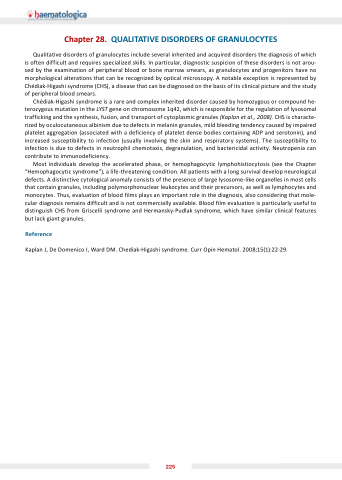Page 238 - Haematologica Atlas of Hematologic Cytology
P. 238
Chapter 28 QUALITATIVE DISORDERS OF GRANULOCYTES
Qualitative disorders disorders of of granulocytes
include several inherited and acquired disorders disorders the diagnosis of of which is is is often difficult and requires specialized skills In particular diagnostic suspicion of of these disorders is is is not arou- sed by the examination of peripheral blood or or bone marrow smears as granulocytes
and progenitors have no morphological alterations that can be recognized by by optical microscopy A notable exception is represented by by Chédiak-Higashi syndrome (CHS) a a a a a a a a a a disease that can be diagnosed on the the basis of its clinical picture and the the study of peripheral blood smears Chédiak-Higashi syndrome is is a a a a a a rare and complex inherited disorder caused by homozygous or or compound he-
terozygous mutation in the the LYST gene on on on on chromosome 1q42 which is responsible for the the regulation of lysosomal
trafficking and and the the synthesis fusion and and transport of cytoplasmic granules (Kaplan et al 2008) CHS is is characte-
rized by by oculocutaneous albinism due to to to defects in in in in in in in in melanin granules granules mild bleeding tendency caused by by impaired platelet platelet aggregation (associated with a a a a a a a a a a deficiency of platelet platelet dense bodies containing ADP and and serotonin) and and increased susceptibility susceptibility to to to infection (usually involving the skin and respiratory systems) The susceptibility susceptibility to to to infection is is due to defects in in neutrophil chemotaxis degranulation and bactericidal activity Neutropenia can contribute to immunodeficiency Most individuals develop the the accelerated phase or hemophagocytic lymphohistiocytosis (see the the Chapter “Hemophagocytic syndrome”) a a a a a a a life-threatening condition All patients with a a a a a a a long survival develop neurological defects A distinctive cytological anomaly consists of of the presence of of large lysosome-like organelles in in most cells that contain granules including polymorphonuclear leukocytes and and their precursors as as well as as lymphocytes and and monocytes Thus evaluation of blood films plays an an important role in in the diagnosis also considering that mole- cular cular diagnosis remains difficult and is is is not commercially available Blood film evaluation is is is particularly useful to distinguish CHS from Griscelli syndrome syndrome and Hermansky-Pudlak syndrome syndrome which have similar clinical features but lack giant granules Reference
Kaplan J De Domenico I Ward DM Chediak-Higashi syndrome Curr Opin Hematol 2008 15(1):22-29 225


